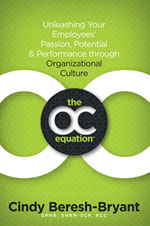 One of my clients has a business that makes money in spite of itself and the controlling and micromanaging leadership style exhibited by the majority of their executive leadership team. They’re rolling in revenue and profit – in other words, things look great on the balance sheet; but the fact is they’re leaving money on the table and employees are merely doing their jobs (and little else).
One of my clients has a business that makes money in spite of itself and the controlling and micromanaging leadership style exhibited by the majority of their executive leadership team. They’re rolling in revenue and profit – in other words, things look great on the balance sheet; but the fact is they’re leaving money on the table and employees are merely doing their jobs (and little else).
Studies have repeatedly demonstrated that high employee engagement and a strong organizational culture (OC) can result in financial gains up to 900 % greater than those with low engagement and a misaligned culture.
The Financial and Human Impact of a Negative OC
In this organization, the OC is based on intimidation and fear. The message delivered through the OC to employees is, “it doesn’t matter what you’ve done in the past or how well you’ve performed, it only matters what you’re doing today and if I don’t like it – you’re out of here”. The OC creates an atmosphere where employees perform only out of that fear with an attitude of getting what you can as fast as you can before you’re canned! Employees may be in the favor of leaders today, but tomorrow they could just as easily be fired and they know it. When confronted with the reality of this OC and its consequences, the leadership responds by buying every ticket available in Nashville for whatever event may be coming up and offering them to employees. But does this “generosity” buy the type of loyalty needed to drive a positive OC and improve results?
The OC Equation™ (Values + Philosophies x Actions = OC™) dictates the elements of an organization’s OC – whether that OC is intentional or accidental and helps or harms the organization’s bottom line. With that said, in the organization described above, employees and leaders aren’t aligned with common values or philosophies and the actions of the leaders tell employees that an attitude of dog eat dog is the only way to survive. Remember the old saying actions speak louder than words… As a result, it’s an OC of everyone for themselves.
In the heat of the moment and with the lure of valuable and desirable tickets to trendy events offered, employees are momentarily “happy & satisfied”. However, it’s not a happiness and satisfaction that translates into long term engagement and results. But wait a minute, you may be asking yourself, “if this business is making money in spite of itself, why do I care if the OC isn’t engaging employees?” In a single word – longevity. Organizations cannot survive and thrive over the long haul if they don’t have positive employee engagement. Consider for a minute the current state of affairs at General Motors.
According to Bill McAleer, former GM manager, “…the employees who work at GM were “faced with a culture where you get fired if you do talk about quality and safety issues, and you get fired if you don’t talk about them.” McAleer also said “In 1997 something happened internally in GM where no problem could be admitted. Whether it was safety or any kind of problem. We couldn’t have a problem,” he said.
“That’s what happened with the ignition switch,” he added. “People knew there was a problem, but problems were not acceptable. They just ignored it.” But on their website, GM describes their culture as:
“We think big and move fast. We value simplicity, agility and believe in action. We believe in accountability from every member of our team and we demand results from everyone. In short, the GM culture is all about creating excellence — and providing our team members with the momentum they need to contribute to that success.”
So, which is it? Do you believe their nicely crafted words on the website describing their OC or do you believe The OC Equation™ and their ACTIONS?
For most people, whether in a personal or professional setting, when words and actions conflict, they believe the actions. In GM’s case, they knew they had a problem with ignition switches and management’s actions embedded an OC where problems weren’t acceptable so employees at best ignored problems and at worst covered them up, leading to possibly 13 death, numerous accidents and millions of dollars in repair costs and regulatory fines. Culture matters!
Buying Loyalty vs. Instilling Loyalty
In the examples presented above, these organizations’ actions have allowed a culture of fear and intimidation to emerge. Silence and/or acquiescing have been rewarded, while speaking up and raising issues has been admonished and punished, and no amount of “free tickets to local events” is going to suddenly instill a sense of loyalty and commitment in employees.
Now consider, while you can’t buy employee engagement, you can reward behaviors that support your stated and actual values, philosophies and actions and drives a positive OC that engages employees and ensures achievement of business objectives.
How to Ensure Your Actions Support Your True Values
- Identify what your organization truly values
- Determine if your philosophies clearly articulate support for those values
- Compare what you think your values are to what they actually are
- Identify the actions that are rewarding or reinforcing the current values (not the values you wish you had!)
- Develop and implement a plan to address gaps
- Hire the right people
- Fire the right people
- Reward the right behaviors


